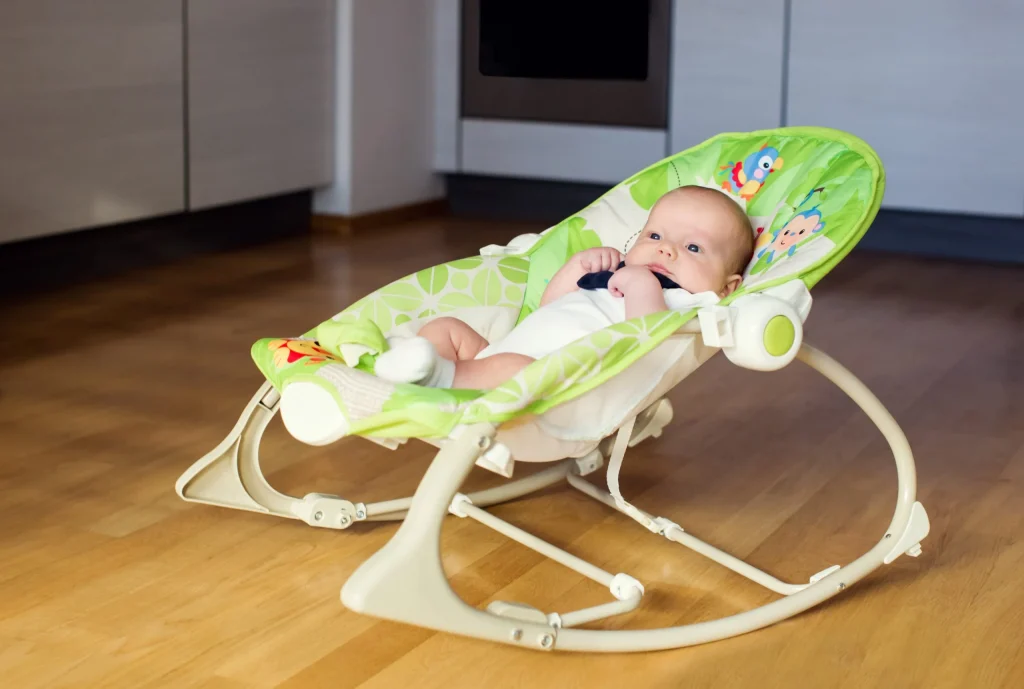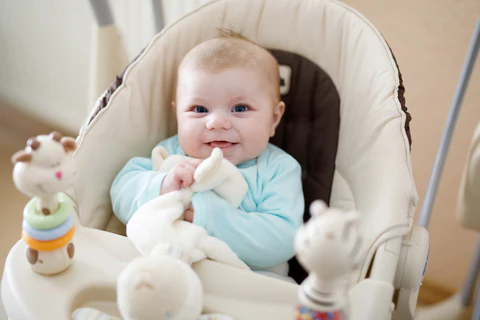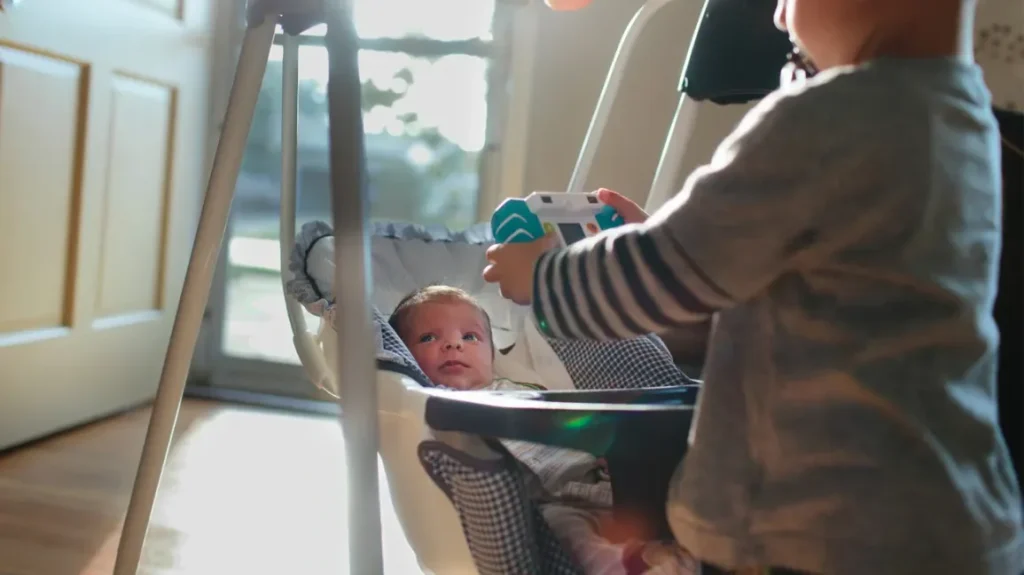Most baby swings are suitable for infants aged 0 to 6 months. Some models can accommodate babies up to 12 months or a specific weight limit.
Choosing the right baby swing can significantly impact your little one’s comfort and safety. Parents often seek a swing that soothes and entertains their babies.
Swings offer gentle rocking motions that mimic the feeling of being held. This soothing motion can help calm fussy infants, making it easier for parents to manage daily tasks.
Safety features, such as harnesses and sturdy bases, ensure your baby remains secure while swinging. Understanding your baby’s age and weight is crucial for selecting the right swing.
Always check the manufacturer’s guidelines to ensure the best fit for your growing child.
Introduction To Baby Swings
Baby swings provide a cozy space for infants. They offer soothing motion and comfort. Parents often use them to calm fussy babies. Swings can be a lifesaver for busy caregivers. Understanding their benefits helps in choosing the right one.
Why Parents Love Them
Parents appreciate baby swings for several reasons:
- Soothing Motion: The gentle sway mimics being held.
- Hands-Free Time: Parents can get tasks done while baby relaxes.
- Multiple Settings: Many swings offer different speeds and sounds.
- Portable Options: Some swings are lightweight and easy to move.
These features make swings a popular choice. They help babies feel secure and relaxed.
Types Of Baby Swings
There are several types of baby swings available:
| Type | Description |
|---|---|
| Traditional Swings | Fixed-frame swings with a seat and motor. |
| Portable Swings | Lightweight and easy to transport. |
| Convertible Swings | Can be used as a swing and a stationary seat. |
| Bouncer Swings | Combination of swing and bouncer for added motion. |
Choosing the right swing depends on your needs. Consider space, portability, and features.

Credit: www.pinterest.com
The Right Age For Baby Swings
Choosing the right time for your baby to use a swing is essential. Understanding the appropriate age can help ensure safety and comfort. Here’s what you need to know about using baby swings.
Minimum Age Recommendations
Most experts recommend waiting until your baby is at least four months old before using a swing. This age allows for better head and neck control. Here are some key points:
- Newborns: Avoid swings for newborns under 4 months.
- Age 4 to 6 months: Safe for use with supervision.
- Age 6 months and up: Baby can enjoy swings longer.
Signs Your Baby Is Ready
Look for specific signs to determine if your baby is ready for a swing:
- Head Control: Your baby should hold their head up steadily.
- Interest in Movement: Watch for excitement in swinging motions.
- Alertness: Baby should be awake and engaged.
Always ensure safety. Use the swing only when supervised. Check weight limits and harness safety before each use.
Safety First: Guidelines To Follow
Ensuring your baby’s safety while using a swing is vital. Follow these guidelines to keep your little one secure and happy.
Weight And Age Limits
Check the manufacturer’s guidelines for weight and age limits. Most swings have specific recommendations:
| Age Range | Weight Limit | Type of Swing |
|---|---|---|
| 0-6 months | Up to 25 lbs | Infant swing |
| 6-12 months | Up to 30 lbs | Baby swing |
| 1-3 years | Up to 50 lbs | Toddler swing |
Always adhere to these limits. This ensures your baby’s safety and comfort.
Proper Usage Tips
- Supervise your baby: Always keep an eye on your child.
- Secure the harness: Buckle the harness snugly before swinging.
- Use on flat surfaces: Place the swing on even ground.
- Avoid overloading: Never exceed the weight limit.
- Check for wear: Inspect the swing for any damages regularly.
Following these tips promotes safety. Enjoy peaceful moments with your baby swinging happily.
Benefits Of Using A Baby Swing
A baby swing offers several benefits for both babies and parents. It provides a safe space for babies to relax. Parents can take a break while their little ones enjoy swinging. Here are some key advantages:
Soothing And Comfort
Baby swings create a calming environment. The gentle rocking motion mimics being held. This helps babies feel secure and relaxed. Here are some soothing benefits:
- Reduces fussiness and crying.
- Helps babies fall asleep faster.
- Offers a cozy spot for rest.
Many parents notice their babies calm down quickly in a swing. This comfort can be essential for busy days.
Developmental Advantages
Using a baby swing can support development. The rhythmic motion stimulates sensory experiences. It encourages babies to explore their surroundings. Key developmental benefits include:
- Improved motor skills.
- Enhanced spatial awareness.
- Better visual tracking.
Swings often come with toys or mirrors. These features promote engagement and curiosity. Overall, swings contribute to a baby’s growth and learning.
Potential Risks And How To Avoid Them
Baby swings can be great for soothing infants. Yet, they come with potential risks. Understanding these risks helps keep your baby safe. Below are key concerns and how to avoid them.
Overuse Concerns
Using a baby swing too much can lead to problems. Babies may become dependent on it. This can affect their natural sleep patterns. Here are some tips to prevent overuse:
- Limit swing time to 30 minutes.
- Use the swing as a supplement, not a replacement.
- Engage in tummy time when not in the swing.
Watch for signs of discomfort. If your baby fusses or cries, take them out. Keeping a balanced routine is essential for healthy development.
Ensuring Safe Sleep
Safe sleep is crucial for your baby’s health. Swings should not replace a crib or bassinet. Babies need a flat, safe surface for sleeping.
| Sleep Location | Features |
|---|---|
| Crib | Flat surface, no soft bedding |
| Bassinet | Small, cozy space, flat surface |
| Baby Swing | Only for short naps, not overnight |
Always supervise your baby in the swing. Use safety straps to secure them. Avoid placing the swing near stairs or hazards. Create a safe environment for your little one.
Choosing The Right Baby Swing
Choosing the right baby swing is essential for your little one. A swing can provide comfort and entertainment. It helps soothe babies while giving parents a break. Knowing what features to look for makes the selection easier.
Features To Look For
Consider these key features when selecting a baby swing:
- Weight Limit: Ensure the swing supports your baby’s weight.
- Speed Settings: Multiple speeds allow customization for your baby’s mood.
- Portability: Look for lightweight swings for easy movement.
- Power Options: Choose between battery-operated and plug-in swings.
Comfort And Safety
Safety and comfort are top priorities. Check these important aspects:
| Feature | Importance |
|---|---|
| 5-Point Harness: | Prevents baby from slipping out. |
| Padded Seat: | Provides comfort during use. |
| Stable Base: | Ensures swing does not tip over. |
| Washable Fabric: | Easy to clean for hygiene. |
Always read safety guidelines before using the swing. Baby swings should meet safety standards. Regularly check for wear and tear. This ensures a safe experience for your child.
Transitioning Out Of The Baby Swing
Every parent wonders when to stop using the baby swing. Understanding the right time is essential for your child’s development. Baby swings provide comfort but can also hinder movement. Knowing when to transition helps promote active play.
Recognizing The Time
Look for these signs that indicate your baby is ready to transition:
- Age: Most babies outgrow swings by 6-9 months.
- Weight: Check the swing’s weight limit; usually around 25-30 pounds.
- Mobility: If your baby can sit up or crawl, it’s time.
- Interest: Notice if your baby prefers to be upright.
- Duration: If your baby spends less time in the swing, consider transitioning.
Alternatives To Consider
There are many options when transitioning from the baby swing. Here are some alternatives:
| Alternative | Benefits |
|---|---|
| Play Mat | Encourages tummy time and exploration. |
| Activity Center | Provides interactive play and supports standing. |
| High Chair | Offers a place for meals and activities. |
| Walker | Promotes mobility and independence. |
Choosing the right alternative depends on your child’s needs. Observe their interests and encourage active play. This transition supports growth and helps develop motor skills.

Credit: www.parents.com
Faqs From Parents
Parents often have questions about baby swings. Understanding their limits and care is crucial. Here are some common inquiries.
Daily Usage Limits
How long can a baby safely use a swing each day? Most experts recommend:
- Limit swing time to 30 minutes per session.
- Do not exceed 1-2 hours total daily use.
Overusing a swing can affect a baby’s development. Always monitor your baby’s comfort and mood.
Best Practices For Maintenance
Maintaining a baby swing ensures safety and longevity. Follow these tips:
- Check for wear and tear regularly.
- Clean the fabric with mild soap.
- Inspect straps for any damage.
- Keep the swing away from hazards.
Always follow the manufacturer’s instructions for care. Proper maintenance helps keep your baby safe and happy.

Credit: www.playlsi.com
Frequently Asked Questions
What Age Is Safe For Baby Swings?
Babies can safely use swings from 4 to 6 months old, when they can support their heads.
Can Newborns Use Baby Swings?
Newborns should avoid swings unless they are specifically designed for their age group, as safety is crucial.
How Long Can A Baby Stay In A Swing?
Limit swing time to about 30 minutes to prevent discomfort and promote healthy development.
Are Baby Swings Good For Sleep?
Baby swings can soothe infants, but they shouldn’t replace safe sleep practices, like crib sleeping.
What Features To Look For In A Baby Swing?
Look for safety harnesses, adjustable recline positions, and stability to ensure your baby’s comfort and security.
Conclusion
Choosing the right age for your baby swing ensures safety and comfort. Most experts recommend using swings for infants aged 4 to 6 months.
Always monitor your baby while swinging and follow the manufacturer’s guidelines. This way, you can create a joyful and secure experience for your little one.
Recent Posts
You are now 15 weeks pregnant and your belly tells it all. The changes occurring to your body are significantly visible and there is no denying the fact you are excited with the turn of events....
Just like it is normal for anyone to be anxious of a new development, when you are 23 weeks pregnant your baby should be preparing for a big surprise – hearing the first sound from the outside...

